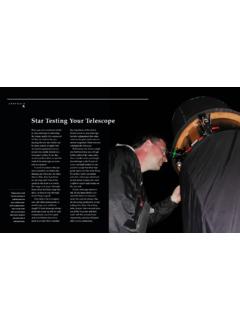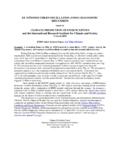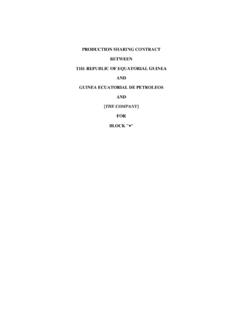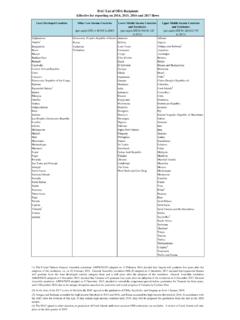Transcription of Polar Aligning Your Equatorial Telescope
1 As the sky turns through the night it revolves around Po-laris, the North Star, so that Polaris barely moves through the night. Polar Aligning is a simple matter of aiming the mount s Polar axis at this a first-time purchaser of an equatorially mounted tele-scope reports that the clock drive doesn t work nothing stays centered, the trouble probably lies not in the drive but in the user s skill at setting up the Telescope . Equatorial mounts with clock drives can provide hands-off tracking of celestial objects. However, for tracking to work as promised, the mount must be aligned to the celestial pole. NOTE: Go To telescopes on fork mounts can be set up to track objects without Polar alignment, just an initial align-ment on two stars. See p.
2 326 of The Backyard Astronomer s Guide for advice on this process. Polar Aligning traditional Equatorial mounts carries the undeserved reputation for being complex and intimidating Indeed, for the perfectionist it can be time consuming. But for the vast majority of backyard stargazers, Polar alignment need take little more time than what A P P E N D I XCit takes to plunk the Telescope mount down with its Polar axis aimed in the correct direction. The time exposure photo at right shows how the mount s fixed Polar axis points north to Polaris. Note that the Telescope itself is aimed south, toward a target of interest. As the sky turns around Polaris (as shown by the star trails), the mount turns about its Polar axis (as shown by the blurry Telescope ).
3 Ah, but how to find Polaris? The Big Dipper s Pointer Stars aim at Polaris, sitting due north and at an altitude above the horizon equal to your latitude. To Polar align a scope you don t need compasses, GPS receivers, or calculations of magnetic devi-ation or sidereal time just aim the Polar axis at Polaris. That s it! Observers in the Northern Hemisphere have it easy they have a bright North Star to aim at. Polar Aligning in the Southern Hemisphere takes more skill as there is no conve-nient South Star. Polar Aligning Your Equatorial Telescope The Quick Way to AlignRigorous, time-consuming methods of precise Polar alignment are necessary only for advanced astrophotography. For general observing, snapshots of the Moon or wide-angle piggyback exposures, an alignment within one or two degrees of the celestial pole will be adequate.
4 This is accomplished in a few seconds by aiming the Polar axis toward Polaris, the North Star, as closely as can be aimed by peering up one of the fork tines and raising or lowering adjustable tripod legs to achieve approximate alignment. Precise leveling is a waste of time for casual point-and-look viewing. The Polar axis of German equato-rial mounts can be eyeballed toward Polaris, as shown at left and on the previous Accurate MethodsFor demanding applications, the Telescope s Polar axis should be within five arc minutes of the true celestial pole. The north celestial pole is conveniently near Polaris, the end star in the handle of the Little Dipper. To be exact, the true pole lies degrees from Polaris in the direction of Alkaid, the end star in the handle of the Big observers in the southern hemi-sphere, locating the south celestial pole is a little more difficult.
5 It lies one degree from a star in Octans called Sigma Octantis, a barely naked eye finder charts included opposite and on page C7 should help you zero in on the celestial pole, north or south. With charts in hand, the next step is to aim the Telescope s Polar axis at the The Backyard Astronomer s Guide 2003C4 The Backyard Astronomer s Guide 2003Up the AxisThe yellow arrow shoots through the Polar axis of this German Equatorial mount. This axis needs to be set at an angle equal to your latitude on Earth, then at night aimed due north to Polaris (or due south if you live in the southern hemi-sphere below the equator). Aligning a ForkThis SCT is set to 90 declination so the fork arms and main tube both aim to the celestial pole. With the scope set like this, use the wedge s altitude and azimuth adjustments (or shift the tripod legs) to aim the finderscope, and therefore the main Telescope , at the pole.
6 It is important to adjust the finder first so that it indeed does point to exactly the same place in the sky as do the main optics. Note that Aligning a Go To fork-mounted scope in this man-ner is necessary only if you wish to take long-exposure astrophotos. Photography, use of analog setting circles, and precision Go To aiming with computerized German Equatorial scopes all require Aligning on the true pole. To find it, imagine its location amid a triangle of stars with Polaris forming one vertex of the triangle. This helpful triangle lies on the side of Polaris opposite another faint star just off Polaris. This true pole position lies away from Polaris toward the direction of Alkaid, the end star of the Big Dipper s handle.
7 The yellow circle marks the field of a typical 6 -wide finderscope. Charts courtesy Starry Night Pro Photography, use of analog setting circles, and precision Go To aiming with computerized German Equatorial scopes all require Aligning on the North Celestial Pole Finder ChartThe Dipper s Pointer stars aim at Polaris. Then, use this finder chart to help you aim your Telescope s Polar axis toward the precise loca-tion of the North Celestial Pole. Keep in mind that simply centering Polaris will provide sufficient accuracy for most visual purposes. NORTHC7 The Backyard Astronomer s Guide 2003 Polar - Aligning FORK-MOUNTED TELESCOPESW hich one is the Polar axis? In fork-mounted telescopes such as Schmidt-Cassegrains, the Polar axis is the one around which the forks revolve.
8 The other motion, which swings the tube up and down through the fork arms, is the declination axis. To be Polar aligned, the Polar axis, and therefore the fork tines, must be aimed at the celestial pole. This requires a wedge, usually optional on Go To models. 1. First, adjust the altitude setting on the wedge to an angle equal to your latitude. From a latitude of 40 degrees North, set the angle on the latitude scale to 40 de-grees. This can be done at any time, even At the observing site, place the Telescope so that its forks are aimed northward. Roughly level the Telescope tripod if you wish, but precise leveling is not Swing the tube so that it reads 90 degrees declination on the circles on the side of the tube, and lock it there.
9 This should put the tube parallel to the forks. For Go To scopes lacking circles use the software routines in the controller to aim at Move the Telescope left to right to cen-ter the pole in the finderscope (or for rough alignment, centering Polaris will suffice). Do this by moving the whole tripod or by using the fine azimuth adjustments on the wedge. Do not alter the Telescope tube s declination or right Move the Telescope up and down to cen-ter the pole in the finderscope. (For this to work the finder must be aligned so it points precisely where the main optics point, an adjustment you can perform in the day-time.) This may mean raising or lowering a tripod leg (it is usually best to have a tripod leg pointing south for this) or using fine altitude adjustments on the wedge.
10 Again, do not move the declination It may be necessary to adjust the azimuth and altitude a few times to refine the aim point. With practice, you ll find that the process takes only 5 to 10 minutes. To aim at the north celestial pole, move the entire Telescope so that the finderscope cross hairs are degrees from Polaris along a line toward the end star in the Big Dipper s handle. If that star is not visible, use a line joining Polaris and Epsilon Cassiopeia, the first star in the distinctive W shape, but still offset toward the Big Dipper s The Backyard Astronomer s Guide 2003 Calibrating the Declination CircleTo locate the pole with the finderscope, the decli-nation setting-circle read-ing must be accurate. In other words, when the tele-scope is set at 90 degrees declination, the tube must be aimed at the same spot that the Polar axis is.







